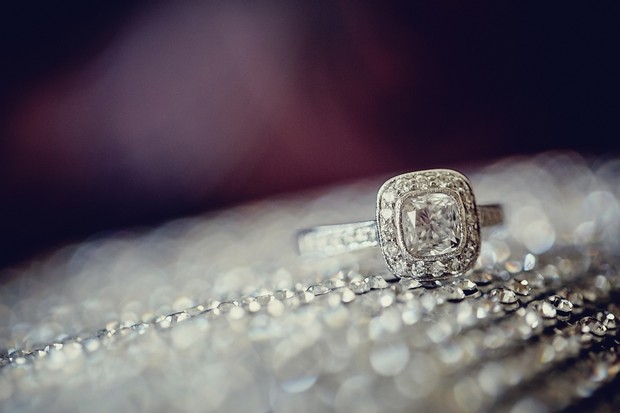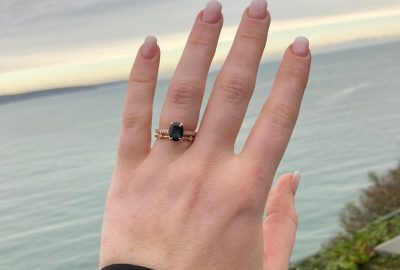Your engagement ring is like no other piece of jewellery you will ever own. There’s the sentimental value, the fact that it will adorn your ring finger every day and of course you will more than likely spend a substantial amount of money on this investment piece too. Buying an engagement ring is a big deal so it makes sense to know a little bit about diamonds before you start the hunt for a sparkler of your own. We asked our experts Peter from Bespoke Diamonds and John from The Wedding Band Shop to share some useful tips when it comes to shopping for an engagement ring…
John from The Wedding Band Shop – www.theweddingbandshop.ie
1. For any couple, buying an engagement is one of the biggest investments of your lives, so it is worth spending the time to do your research to get the ring that you want. The stone, usually a diamond, is the feature piece of any engagement ring. Familiarise yourself with the 4 C’s; these are the carat, colour, clarity and cut of the gemstone. You will need to balance the qualities of these factors to get the diamond that is right for you at an affordable price.
2. If you are working with a small budget, you should consider the 5th C; cubic zirconia. A cubic zirconia stone is indistinguishable from a real diamond except by an expert, but is a fraction of the cost. You could always plan on replacing the c.z. stone with a real diamond later in life when finances improve. Make sure that you receive your certificate with your diamond, the two go together.
3. Shop around. There are plenty of options available. High street stores are a good place to start as you will get a good idea of what styles are available and a good indication of price. If you are looking for vintage, there are plenty of shops in and around the Powerscourt Centre that stock a good range of upcycled rings. In recent years, a number of boutique diamond retailers have popped up off the high street. Certainly, they are worth meeting as they can offer value. However, don’t feel pressured to buy just because they have invested time in you.
4. Internet retailers, are very competitive on price, but just remember that the price you see is not necessarily the price you pay. Bank charges, duties and taxes, if the ring is being shipped into Ireland, can really add to the cost. Also, be aware that the image of the ring you are viewing is not necessarily the image of the ring you are buying. If you choose to buy online, remember you can always get all your money back if you decide to return the ring.
5. Some couples choose to go to Antwerp or New York to purchase their ring. There are good deals to be got there, but just be aware that the guys you meet at the stores there are very good sales people who know that you are there for the weekend to buy and will price accordingly. Drive a hard bargain.
6. Don’t forget the most important factor for you to consider when purchasing your engagement ring is price. Decide on how much you are willing to spend and stick to your budget. Good Luck!
Peter from Bespoke Diamonds – www.bespokediamonds.ie
1. Set a Budget – this is the first thing that we would encourage you to do and even more importantly stick quite rigidly to this!
2. Familiarise yourself with the 4 C’s – here’s a brief outline but you can find more detailed information here:
Colour: Diamonds range in colour from D (which would be a colourless diamond) to Z (a diamond with a strong yellow tint). Diamonds that are in the range from D to F are generally regarded as being colourless and will therefore be more expensive, diamonds in the range G to H are near colourless and are what a lot of people aim for. We advise you to view the diamond in day light as many jewellers have lights which makes a diamond look brighter than it actually is. Just ask the Jeweller if you can take the diamond outside to see it in natural light to get a real sense of the diamond’s colour. By reducing the colour ranking of the diamond, this could result in some savings with minimal consequence.
Diamond Carat: This relates to the weight of a diamond. Prices jump at what jewellers call ‘magic points’. Magic points are 0.5ct, 1 ct, 1.5ct, 2ct etc. A big tip here is to buy a diamond where the weight is just under one of the magic points. For example a 0.9ct stone can cost up to 20% less than a 1 ct stone with both diamonds looking very similar in size.
Diamond Clarity: This refers to the number of inclusions (blemishes) that a diamond may or may not have. Clarity ranges from Flawless to Heavily Included (inclusions visible to the naked eye). Only 1% of the world’s diamonds are flawless. The best value for money would be VS2/Si1, be careful when buying Si1 clarity stones as quite a number of them have visible inclusions if you look closely enough. If you reduce the clarity in your diamond this would save you money. At Bespoke Diamonds, we example 20-30 diamonds in the Si clarity range and may select one good one for a customer. This is important to note if you are choosing a diamond online where you are not able to see before you buy, which can be risky.
Diamond Cut: This is the most important of the 4 C’s. Many people get confused between the cut and the shape of the diamond. Shape refers to Round, Princess, Cushion, Pear, Emerald etc, while cut refers to how well the diamond was crafted from its rough state. If a diamond is not cut correctly, it will not sparkle! The cut grade scale is Excellent, Very Good, Good, Fair and Poor. Always select a diamond that has an Excellent or Very Good Cut grade otherwise you may be disappointed when you leave the bright lights of the jewellers.
3. Always ask to see the Diamond certificate when buying a certified diamond. This is often regarded as the fifth C. Many people incorrectly believe a diamond with a certificate means it is not a ‘blood diamond’. The two are not related in any way. A certificate simply means that the carat, colour, clarity, cut has been verified by an independent third party. The top three certification bodies in Europe are GIA/HRD/IGI.
4.Enquire regarding the Diamond Fluorescence – This refers to the diamonds reaction to Ultra Violet (UV) light. If a diamond has fluorescence it may turn milky/cloudy on a sunny day when there is strong UV light. Your diamond may also turn blue under artificial UV light. There is a scale for fluorescence – Nil, Faint/Slight, Medium, Strong and Very Strong. Where possible, one should buy diamonds with only Nil or Slight, prices drop significantly when the fluorescence is medium or stronger.
5. Be aware of the ring metal – yellow gold,platinum or white gold. This is a matter of taste. White gold stays fresher looking for much longer than platinum, white gold is a little lighter than platinum and needs to be rhodium plated every 12-18 months, this costs approx. €20. Platinum goes a dull greyish colour very quickly but is regarded as the strongest precious metal and most resistant to damage. Many jewellers will promote platinum mainly due to the fact that there is a larger margin on this metal. Palladium is another option that is similar to platinum and white gold but is less expensive. It is a strong metal, has a permanent whiteness, is easy to polish and repair and is scratch resistant.
6. Consider the ring style – different diamond shapes will look better on different people’s hands. A diamond raised up on a mount will usually make a finger look slimmer. Three stone rings usually look best on short fingers. Some styles, while may look nice in a jewellers window/website, will not suit your hand. Try on many styles and diamond shapes to ensure you know what style and shape you prefer and which one suits you best.
7. Shop around and haggle – it may sound obvious but ensure that you shop around so that you get the best ring you can for your budget. You will be amazed at how much money you can save by doing this and don’t be afraid to let the Jeweller know that you are getting a certain deal with another Jeweller, perhaps they can match or better this. Finally remember the Appointment only Jeweller such as Bespoke Diamonds is gaining much popularity for very good reason. The most important advantage is that generally they are much more affordable – your budget will get you a much better quality diamond.
Photo from Ross & Amy’s real wedding by DKPHOTO




